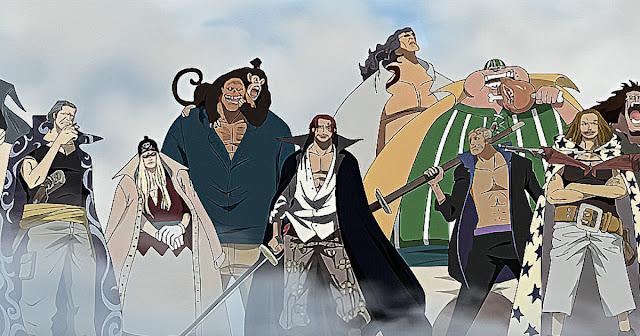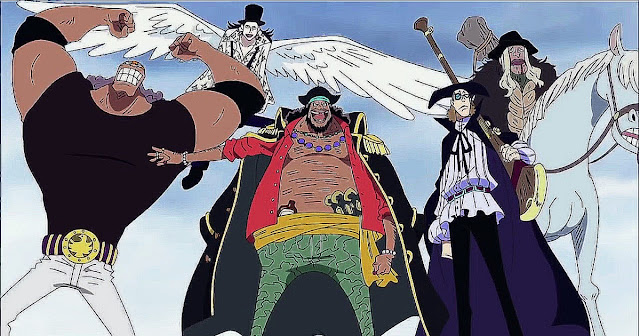

Special
The Unique Strengths of the Yonko Crews in One Piece
In the world of One Piece, the Yonko, or Four Emperors, are some of the most powerful and influential pirate crews. Each Yonko crew has its own unique strengths and qualities that set them apart from one another. While individual combat prowess is essential, what makes the balance of power among the Four Emperors so fascinating is the various factors beyond each captain’s strength. From subordinates and territories to alliances and strategies, these elements come together to create a diverse landscape in the pirate world.
The Whitebeard Pirates

The Mighty Military Fleet– The Whitebeard Pirates are a force to be reckoned with. They have a massive fleet of ships and a crew of mighty fighters, led by the legendary Edward Newgate. Their military might is unmatched, and they are a significant threat to the World Government.
But the Whitebeard Pirates are more than just a powerful fighting force. They are also a family. The members of the crew are fiercely loyal to each other, and they would do anything for their captain. This sense of family is what makes the Whitebeard Pirates so strong.
The Red-Haired Pirates

The Enigmatic Core Crew– The Red-Haired Pirates are another powerful crew, but they are much more mysterious than the Whitebeard Pirates. We don’t know much about their fighting abilities, but we do know that they are highly respected by the other Yonko crews.
What makes the Red-Haired Pirates so dangerous is their strategic genius. Their captain, Shanks, is a master of planning and deception. He is always one step ahead of his opponents, and he is never afraid to take risks.
The Beast Pirates

Weapons Arsenal– The Beast Pirates are the newest Yonko crew, and they are already making a name for themselves. Their captain, Kaido, is one of the strongest pirates in the world, and he is known for his ruthlessness.
The Beast Pirates are also well-armed. They have access to a variety of weapons, including chemical weapons and Sea Stone weapons. This makes them a major threat to any who oppose them.
The Big Mom Pirates

Political Leverage and Negotiation– The Big Mom Pirates are a force to be reckoned with. They are led by the mighty Big Mom, who is known for her manipulation and ruthlessness. The Big Mom Pirates have a vast network of allies, and they are always looking to expand their influence.
The Blackbeard Pirates

Strategic Genius– The Blackbeard Pirates are the newest Yonko crew, and they are already making a name for themselves. Their captain, Blackbeard, is a master of deception and trickery. He is always looking for ways to gain power, and he is not afraid to do whatever it takes to achieve his goals.
Cross Guild
Public Manipulation– Cross Guild is a relatively new crew, but they are already making a name for themselves. They are led by the infamous Buggy, who is known for his charisma and cunning. Cross Guild is not as powerful as the other Yonko crews, but they are still a force to be reckoned with.
The Straw Hat Pirates

Unparalleled Growth Rate– The Straw Hat Pirates are the protagonists of One Piece, and they are still relatively new to the world of piracy. However, they have already made a name for themselves as a crew of talented fighters and resourceful adventurers.
The Straw Hat Pirates are led by Monkey D. Luffy, who is determined to become the Pirate King. Luffy is a natural leader, and he has a knack for inspiring others. He is also a gifted fighter, and he is always looking for new ways to improve his skills.
The Straw Hat Pirates are still growing and learning, but they have the potential to become one of the most powerful pirate crews in the world. They are a force for good in the world, and they are always willing to help those in need.
Conclusion
The Yonko crews are all formidable forces, but each has its own unique strengths and weaknesses. It will be interesting to see how the power balance shifts as the story progresses.
Special
[One Piece Spoiler]Predictions for the development and content of episode 1154 | Is “Loki’s Curse” revealed?[ONE PIECE]
![[One Piece Spoiler]Predictions for the development and content of episode 1154 | Is “Loki’s Curse” revealed?[ONE PIECE] [One Piece Spoiler]Predictions for the development and content of episode 1154 | Is “Loki’s Curse” revealed?[ONE PIECE]](https://eiga-manga.com/wp-content/uploads/2025/06/ONEPIECE1154話アイキャッチ仮.jpg)
We are predicting the content and development of episode 1154 of “ONE PIECE,” which will be published in Weekly Shonen Jump issue 33 (July 28th issue), which will be released on Monday, July 14th. Characters that appear and are thought to be active in the latest episode 1154 of One Piece, and more (…)
The post[One Piece Spoiler]Predictions for the development and content of episode 1154 | Is “Loki’s Curse” revealed?[ONE PIECE]first appeared on Manga Review Blog | Shindolog.
Special
[Latest One Piece Episode]Summary of spoilers and thoughts on episode 1153 | ONE PIECE depicts the process of Loki’s birth
![[Latest One Piece Episode]Summary of spoilers and thoughts on episode 1153 | ONE PIECE depicts the process of Loki’s birth [Latest One Piece Episode]Summary of spoilers and thoughts on episode 1153 | ONE PIECE depicts the process of Loki’s birth](https://eiga-manga.com/wp-content/uploads/2025/06/ONEPIECE1153話アイキャッチ.jpg)
This article contains spoilers for episode 1153 of “Loki’s Birth”, published in Weekly Shonen Jump 2025 issue 31 (July 14th issue) on Monday, June 30th. The latest episode revealed in Heildin’s mother, Ida and King Harald (…)
The post[Latest One Piece Episode]Summary of spoilers and thoughts on episode 1153 |[ONE PIECE]depicts the process of Loki’s birth first appeared on Manga analysis blog | Shindolog.
Special
[One Piece]Summary of spoilers and thoughts on episode 1152 | The truth behind King Harald’s death is revealed[ONE PIECE]
![[One Piece]Summary of spoilers and thoughts on episode 1152 | The truth behind King Harald’s death is revealed[ONE PIECE] [One Piece]Summary of spoilers and thoughts on episode 1152 | The truth behind King Harald’s death is revealed[ONE PIECE]](https://eiga-manga.com/wp-content/uploads/2025/06/ONEPIECE1152話アイキャッチ.jpg)
This article contains spoilers for episode 1152 of “ONE PIECE,” published in Weekly Shonen Jump 2025 issue 30 (July 7th issue) on Monday, June 23rd. Loki Gavan discovered in episode 1152 of the incident that he learned about 14 years ago (…)
The post[One Piece]Summary of spoilers and thoughts on episode 1152 | The truth behind King Harald’s death is revealed[ONE PIECE]first appeared on Manga Review Blog | Shindolog.



.png)







